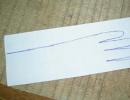Presentations on sensory development in young children. Presentation "Sensory development of young children in different types of activities." Tasks of sensory development of young children
1 of 23
Presentation - Sensory education of children of senior preschool age
Text of this presentation
Prepared by: teacher of GBOU School No. 41, preschool groups No. 2 Trofimenko E.V.
Sensory education of children of senior preschool age

There are five sensory systems through which a person experiences the world: vision, hearing, touch, smell, taste.
What is sensory?

Sensory (from Latin sensus, “perception”) is a category that describes the direct perception of sensations and external influences. In physiology, sensory is a function of the nervous system that consists in the perception of external stimuli.
Sensory education is a system of pedagogical influences aimed at developing ways of sensory cognition and improving sensations and perceptions.

The goal of sensory education is to develop sensory abilities in children. Sensory abilities develop in the process of development of perception, which is determined by the assimilation and use in activity of systems of perceptual actions and systems of sensory standards.

The meaning of sensory education: - develops observation skills; - affects the aesthetic feeling; - develops attention; - gives the child the opportunity to master new methods of subject-cognitive activity; - ensures the assimilation of sensory standards; - ensures the development of skills in educational activities; - influences the expansion of the child’s vocabulary; - affects the development of visual, auditory, motor, figurative and other types of memory.

Tasks: At an early age: accumulation of ideas about color, shape, size (it is important that these ideas are varied). In middle preschool age: - sensory stages are formed - stable ideas about color, geometric shapes, relationships in size between several objects. - formation of sensory standards; - learning to group objects according to one or more characteristics; development of analytical perception - the ability to understand the combination of colors, dissect the shape of objects, and isolate individual quantities. In older preschool age: - distinguishing speech sounds and distinguishing the perception of the outline of letters
- development of fine motor skills, - establishing similarities and differences between objects

Integrating Sensory Development with Other Areas: Cognitive Development Language Development Social Communication Development

Sensory standards: colors; forms; quantities; taste; sense of smell; time; standards of spatial representations; standards of touch.

Stages of sensory education: – formation of sensory standards – learning how to examine an object, – distinguishing shape, color and size, performing more complex visual actions. – development of analytical perception: the ability to understand combinations of colors, dissect the shape of objects, highlight individual dimensions of size.

At five years old, a child should know 5 basic shapes - square, triangle, circle, rectangle and oval.
In older preschool age, children develop ideas about individual dimensions of size: length, width, height, as well as spatial relationships between objects. They begin to indicate how objects are located relative to each other (behind, in front, above, below, between, left, right, etc.). It is important that children master the so-called eye actions. After this, they move on to solving problems “by eye”.

The development of these abilities is closely related to the development of speech, as well as to teaching children to draw, sculpt, design, that is, productive types of activities. Productive activity presupposes the child’s ability not only to perceive, but also to reproduce the features of color, shape, size of objects, their location relative to each other in drawings and crafts. For this, it is important not only to assimilate sensory elements, but also to develop unique perceptual actions. To develop sensory abilities, there are various games and exercises that will help unleash the child’s creative potential and enrich his emotional world.

Games to develop tactile sensations
“Wonderful bag.” Objects of different shapes, sizes, textures (toys, geometric shapes and bodies, plastic letters and numbers, etc.) are placed in an opaque bag. The child is asked to find the desired item by touch, without looking into the bag.
"Handkerchief for a doll." (identification of objects by the texture of the material). Children are offered three dolls in different scarves (silk, wool, knitted). Children take turns examining and feeling all the handkerchiefs. Then they are removed and placed in a bag. Children find the right handkerchief for each doll by touch.

"Guess by touch." The child is asked to determine by touch what material he is touching. Material: plastics covered with velvet, sandpaper, foil, corduroy, flannel, silk.
"Recognize the figure." Geometric shapes identical to those in the bag are laid out on the table. The teacher shows any figure and asks the child to take the same one out of the bag.

Games to reinforce the concept of shape
“Name the shape of the object.” Goals: to consolidate the ability to visually correlate the shape of an object with a standard. An adult places the toy in a certain place. the child determines the location of this toy (in the room, on the table, to the right/left of...)
“Which figure is extra.” The child is offered various sets of four geometric shapes. For example: three quadrilaterals and one triangle. three ovals and one circle. It is required to identify the extra figure, explain the principle of exclusion and the principle of grouping.

“Make a whole from parts.” Make a design from several geometric shapes according to the model. Make a design from memory, according to the description. Compose a figure by selecting the necessary parts from the many proposed parts.
"Define correctly." The child is asked to determine from the drawings what geometric shapes the object consists of.

Didactic games and exercises to reinforce the concept of quantity
“Pick a pair by color” You need to find a pair of objects of the same color. During the game you need to make five logical pairs of ten different objects.
“Further is closer.” Using a drawing of a forest, children determine which trees are closer and which are further away.

“Place in order” The child is asked to compare and arrange objects along one dimension, distracting from other dimensions: arrange the cylinders in increasing (decreasing) height; arrange the bars in increasing (decreasing) length or width.
“Which box?” divide five types of toys of different sizes into five boxes depending on size.

Didactic games and exercises for fixing colors
“What color is missing?” Children are shown several flags of different colors. and then close their eyes. The teacher removes one of the flags. Determine which color is gone.
"Collect the caterpillar". Goal: collect a caterpillar from different colors, starting from dark to light and vice versa.

“Weave a rug from colored stripes.” Children look at a pattern of a rug made of colored stripes, then weave a rug from memory, repeating the alternation of colors in the pattern.
“Fold the Rainbow” Prepare colored arcs, cut them in half. Assemble one half yourself and let your child assemble the other half. Offer to name the colors (red, orange, yellow, green, blue, indigo, violet).
“Inseparable colors” The teacher names an object in which different colors are presented in constant combination, the children name them. For example: “Rowan”, children answer: “The leaves are green, the berries are red.”

We use various didactic simulators, games, and manuals that help develop tactile sensitivity and fine motor skills in children.
"Using Massage Balls" Balls of different shapes, elasticity, and surface textures provide a wide range of different sensations that can be obtained by handling these objects independently.

You can make “Tactile Baths” - scatter peas or beans, beans, acorns in a small box. Searching for small objects in such a “bath” helps to activate finger gnosis.
“Sensory path for feet” is a carpet path on which “bumps” of different textures are attached using Velcro: bags made of thin but durable fabric with different fillings (rags, pieces of leather, foam rubber, small pebbles, peas). The variety of sensations makes walking along the path exciting. Such walking is useful for the development of tactile perception, as well as for coordination of movements and the prevention of flat feet.
To view the presentation with pictures, design and slides, download its file and open it in PowerPoint on your computer.
Text content of presentation slides: Sudnishnikova Elena Vladimirovna S.P. Pokur MBOU “Pokurskaya OSSH” Sensory education of young children (from work experience)
Sensory education means targeted improvement and development of sensory processes (sensations, perceptions, ideas) in children. The goal of sensory education is the formation of sensory abilities in children. A child’s sensory development is the development of his perception and the formation of ideas about the external properties of objects: their shape, color, size, position in space, as well as smell, taste, etc. On this basis, the following tasks are highlighted: 1. Formation of systems of perceptual actions in children 2. Formation of systems of sensory standards in children 3. Formation in children of the ability to independently apply systems of perceptual actions and systems of standards in practical and cognitive activities
Reference systemColorsShapesMeasures
Orientate yourself in 6 colors, name them, select them according to the sample; navigate in three or more contrasting values; assemble a pyramid of 5-8 rings of different sizes; correlate the configuration of a three-dimensional geometric figure with a planar image; apply it to the sample (lays out inserts of different sizes or shapes in similar holes on the board) - make up a whole from 4 parts of cut pictures, folding cubes. Requirements of the sensory education program from 2 to 3 years: Requirements of the sensory education program from 2 to 3 years:
D/I dress up the sun using didactic games; creating conditions for children to become familiar with color, shape, size. Didactic games Didactic game “Which tree is the leaf from? ", "Big and small leaf" Purpose: To form ideas about color and size. Didactic game “Pick a Shape” Goal: to teach children to select shapes for geometric patterns Testoplasty Working with salt dough has a cumulative effect on the development of the baby - increases sensory sensitivity, promotes a delicate perception of shape, weight, plasticity, texture, forms imagination, plastic awareness, fine motor skills, synchronizes the work of two hands promotes perseverance and vigilance, and also opens up the creative principle in the child. Advantages of salt dough over plasticine and clay: Can be prepared at any time. Easy to clean and leaves no marks. Safe if it gets into the mouth. Does not stick to hands when sculpting. Can be air dried. Can be sculpted from colored dough and can be painted on the finished product .If varnished, it will last for centuries. You can play with toys made from salt dough without fear, they will not lose their shape. This material is pleasant to the touch, warm, gentle, completely harmless from the point of view of the environment and allergens. Development of fine motor skills, development of the “hand” ", manual skill must be given special attention. And children of other age groups also feel the need for this, since the development of the motor sphere is an important condition for general mental development. This dough can be used for games and modeling with children at home, as well as in kindergarten classes. Exercises with dough: 1. Pinch off pieces with two fingers, then stick them on (for example, eyes). 2. Clap the dough, flatten it with your whole palm, roll sausages with your palm and each of your fingers. 3.You can make prints of legs and arms 4.Print fingers and sticks on the dough. 5. Combine the dough with other materials (peas, beans, twigs, vermicelli, straws) 6. You can make rings and string them on a string. Treats for chickens. The goal is to introduce modeling. The goal is to form and master the basic skill of plucking. Together with the guys, prepare a treat for the chickens. You will need dough and several toy chickens. Divide the activity into three stages. Meet the characters Place the chickens in a bright box without the kids noticing. Let them try to guess who is hiding there. Look at what the chickens look like and offer to prepare a treat for them. Modeling Make grains for the chickens. Show how to pinch off small pieces of dough. If it is still difficult for your child to do such work, do it yourself. Place the finished grains on a flat plate. Lunch Bring the chickens, place them near the plate with grains and feed them. And at the end, let them not forget to thank the kids. In 2012-2013, the age of children in our group was from 1 year. 8m. up to 5 years old. The sensory abilities of children were tested. I found out that only a small part of them distinguishes between basic colors and sizes, and only a few tried to distinguish shapes and distinguished them. In my work, I outlined the following conditions for completing the tasks: using didactic games, creating conditions for familiarizing children with color, shape, and size. Work was also carried out with parents. Consultations were conducted and documented. She told parents in detail at a parent meeting about the content of the work to familiarize children with color, shape, size, the importance of timely education of sensory abilities, as well as what work should be done in the family to consolidate skills. An exhibition of didactic games and toys was organized to help reinforce sensory standards. She explained to adults how to play these games with children, what toys and educational games can be purchased for children, and how to design a play corner at home. Joint and systematic work had a positive impact on the development of sensory abilities of the children in our group. Thank you for your attention!
Attached files
Marina Khramova
Presentation “Sensory development of young children”
This presentation was shown to parents at a parent meeting dedicated to topic: "Sensory development of young children" .
Target: Introducing parents to games developing sensory abilities in children.
Tasks:
1. Introduce parents to the standards sensory development of young children.
2. Encourage parents to create conditions for the formation of perception as the initial stage of cognition of the surrounding reality.
3. Expand parents’ understanding of exercises and games for development tactile sensitivity, visual and auditory perception.
Introduced parents to the features sensory development of children at this age. Sensory education develops in children fine motor skills of the fingers, various hand movements when performing various manipulations with objects. For development fine motor skills in this presentations sample games were shown for sensory development of children.
Publications on the topic:
Sensory development of young children 1 word The process of cognition of a small person differs from the process of cognition of an adult. Adults understand the world with their minds, small children with their emotions.
Self-education report “Sensory development of young children” Video In the 2014-2015 academic year, I continued the topic of self-education: “Sensory development of young children.” Development of sensory abilities.
Sensory development of young children The period of early childhood is characterized by intensive development of the perception process. Not by chance.
Methodological development “Sensory development of young children” Explanatory note Early childhood is a special period of formation of organs and systems and, above all, brain function. Early age is the best.
The process of cognition of a small person differs from the process of cognition of an adult. Adults understand the world with their minds, small children with their emotions. Cognitive.
Long-term plan for self-education “Sensory development of young children” Municipal budgetary preschool educational institution “General developmental kindergarten No. 135” Long-term plan for self-education.
Outline of the parent meeting “Sensory development of young children” Municipal budgetary preschool educational institution "Kindergarten No. 97" Plan - summary of the parent meeting In the early group.
 In our early childhood group, we pay special attention to the sensory development of children. To attract the child's attention to the properties of objects.
In our early childhood group, we pay special attention to the sensory development of children. To attract the child's attention to the properties of objects.
In the presentation, kindergarten teachers will be able to refresh their knowledge about the sensory development of preschool children. As educators, we know how important sensory education is throughout preschool development. Thanks to sensory development, we educate a personality that grows and develops through knowledge of the world around us through exposure to all senses. The most interesting thing is that we can make many sensory development games ourselves. This is what is discussed in the presentation. If the topic interests you, then after watching the presentation and studying the games that are offered on the Internet for self-production, you yourself will be able to replenish your collection of educational games. I wish you good luck!
Download:
Preview:
To use presentation previews, create a Google account and log in to it: https://accounts.google.com
Slide captions:
Sensory development of preschool children Games aimed at sensory development.
Sensory education is an integral part of the full development of a child’s personality. Just as a sponge absorbs moisture, so a child, with the help of an adult, learns about the world around him. And the brighter and more colorful an adult shows our world to a child, the richer and brighter the child’s perception of reality will be. The concept of “sensory” has a Latin root – “sensus” (feeling, feeling), therefore sensory education of a child implies the influence of the teaching and development environment on the child’s senses. And it is quite logical to assume that this effect will be determined by the age of the child. A child’s sensory development is the development of his perception and the formation of ideas about the external properties of objects: their shape, color, size, position in space, smell, taste, etc. The importance of sensory development The importance of sensory development in early and preschool childhood cannot be overestimated. It is this age that is most favorable for improving the functioning of the senses and accumulating ideas about the world around us.
A child's readiness for school largely depends on his sensory development. Research conducted by child psychologists has shown that a significant part of the difficulties that children encounter during primary education (especially in 1st grade) are associated with insufficient accuracy and flexibility of perception.
There are five sensory systems through which a person experiences the world: vision, hearing, touch, smell, taste.
In the development of sensory abilities, an important role is played by the development of sensory standards - generally accepted examples of the properties of objects. For example, the 7 colors of the rainbow and their shades, geometric shapes, the metric system of measures, etc. There are various games and exercises to develop sensory abilities.
Sensory development, on the one hand, forms the foundation of the general mental development of the child, on the other hand, it has independent significance, since full perception is necessary for the successful development of the child in kindergarten, schooling, and for many types of work activities. Knowledge begins with the perception of objects and phenomena of the surrounding world. All other forms of cognition - memorization, thinking, imagination - are built on the basis of images of perception and are the result of their processing.
At each age, sensory education has its own tasks, and a certain element of sensory culture is formed. We can highlight the main tasks in the sensory development and upbringing of children from birth to 6 years. In the first year of life, this is the enrichment of the child with impressions. The child follows moving bright toys and grabs objects of different shapes and sizes.
In the second or third year of life, children must learn to identify color, shape and size as special characteristics of objects, accumulate ideas about the main varieties of color and shape and the relationship between two objects in size.
Starting from the fourth year of life, children form sensory standards: stable ideas about colors, geometric shapes, and relationships in size between several objects, enshrined in speech. Later, one should become familiar with shades of color, with variations of geometric shapes and with the relationships in size that arise between the elements of a series consisting of a larger number of objects.
Simultaneously with the formation of standards, it is necessary to teach children how to examine objects: grouping them by color and shape around standard samples, sequential inspection and description of the shape, and performing increasingly complex visual actions. Finally, a special task is the need to develop analytical perception in children: the ability to understand color combinations, dissect the shape of objects, and isolate individual dimensions of size.
Sensory tracks Tactile cards Items for the development of tactile sensations Sound toys To develop sensory abilities, there are various games and exercises. We can make many of them with our own hands. Thank you for your attention!
Sensory education
children of primary preschool age through didactic games.
A child’s sensory development is the development of his perception and the formation of ideas about the most important properties of objects, their shape, color, size, position in space, as well as smell and taste. The period of the first three years is the most intensive mental and physical development of children. The success of a child’s mental, physical, and healthy development largely depends on the level of sensory development, i.e. depends on how much the child hears, sees, touches the world around him.
The importance of sensory education is that it: is the basis for intellectual development, develops observation, has a positive effect on the aesthetic sense, is the basis for the development of imagination,
develops attention, gives the child the opportunity to master new methods of subject-cognitive activity, ensures the assimilation of sensory standards, ensures the development of skills in educational activities, influences the expansion of the child’s vocabulary, influences the development of visual, auditory, motor, figurative and other types of memory.
Didactic play plays a huge role in the development of sensory abilities of young children, since a child learns almost everything in this world through play. Didactic games perform the function of monitoring the state of sensory development of children

Sensory development- purposeful development and improvement of sensory processes such as sensation, perception, representation.
Main task– teach children to perceive objects, clearly distinguish between their numerous properties and relationships (shape, color, size, location in space, etc.)

Target sensory education - is the formation of sensory abilities in children.
Tasks:
- Formation of perceptual action systems in children;
- Formation of systems of sensory standards in children;
- Formation in children of the ability to independently apply systems of perceptual actions and systems of standards in practical and cognitive activities.

Reference system
Colors
Forms
Quantities

Didactic games -
This is a type of games with rules, specially created by pedagogy for the purpose of teaching and raising children. They are aimed at solving specific problems of teaching children, but at the same time, they demonstrate the educational and developmental influence of gaming activities







Competition games
Games of forfeits or games of a forbidden “penalty” object (picture) or its properties (for example, color )

In the general system of sensory education in kindergarten didactic games solve educational problems. In addition, they are a good school for children to use the acquired sensory experience, ideas and knowledge and, finally, perform the function of controlling the progress of sensory education.






